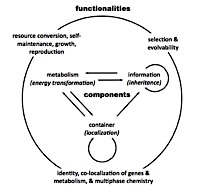All life forms are composed of molecules that are not themselves alive. But how exactly do living and nonliving matter differ? Is there a fundamental difference at all? How could we possibly turn a collection of nonliving materials into something that is, at least operationally speaking, alive? In the context of PACE we a developed a compendium of the state of the art on attempts to answer these questions by building bridges between nonliving chemistry and emergent living states of matter (Rasmussen et al., 2008 and Sole et al., 2007). It focuses on attempts to create very simple life forms in the laboratory. These new forms of life might be quite unfamiliar. In PACE we have focused on two different experimental approaches towards protocells while we in addition have investigated a variety of computational approaches.
A living system can be operationally defined as a system that integrates three critical functionalities (figure 1, outer ring): First, it maintains an identity over time by localizing all its components. Second, it uses free energy from its environment to digest environmental resources in order to maintain itself, grow, and ultimately reproduce. Third, these processes are under the control of inheritable information that can be modified during reproduction. These properties enable selection and thus evolution as part of the reproduction process. Living systems are sometimes said to include various further essential properties, such as autonomous information processing, sensitivity to the environment, self-organization, and purposeful behavior. We agree that these are central properties of living systems, but we hold that they are derivative in the sense that they are effectively implied by the functionally integrated triad described previously.
In (Rasmussen et al., 2008 and Sole et al., 2008) we aim to provide a very general understanding of how one could obtain entities with these lifelike properties from experiments that begin with nonliving materials. It generally reflects the perspective that chemical instances of such forms of life must embody the three operational functionalities in three integrated chemical systems: a metabolism that extracts usable energy and resources from the environment, genes that chemically realize informational control of living functionalities, and a container that keeps them all together (see figure I.1, inner triangle). We will use the term protocell to refer to any realization of these three functional components. Our usage is close to the engineering word prototype, that is, an artificial structure that represents the first simple working model of a designed system. The importance of cooperative structures for minimal life was initially stressed in Eigen’s hypercycle concept ( Eigen, 1971), which focused on the cooperation between informational structures (genes). Ganti (1975) first identified the minimal cooperative structure capable of forming a cell as the triad of genes, metabolism, and container.
We use the terms container, metabolism, and gene quite generally, with minimal presupposition concerning their chemical details. In most contexts, the container will be an amphiphilic structure such as a vesicle or micelle, but immobilizing chemicals on a surface can also achieve the required spatial localization. Similarly, metabolism could harvest redox energy or light, it could work with more or less complex material precursors, and it might or might not use adenosine triphosphate (ATP) and complex enzymes. Furthermore, genes might achieve informational control and inheritance with some nucleotide other than DNA, or even without using any biopolymers.






